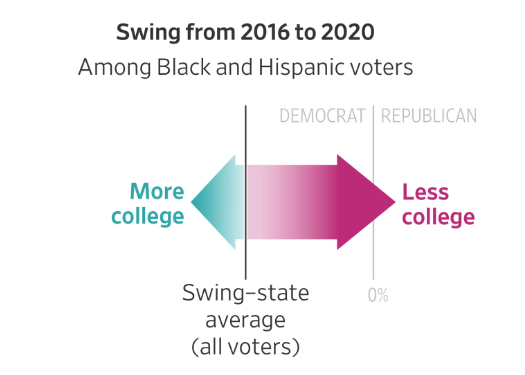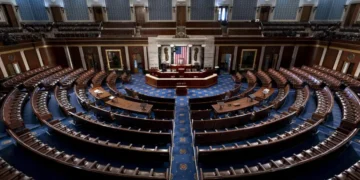Nov 4, 2024 Story by: Editor
As Democrats aim to secure critical swing states in the upcoming election, a troubling trend is emerging within Black and Hispanic communities: the college diploma divide.
An analysis of detailed voting and demographic data by The Wall Street Journal reveals that while support for the Democratic Party grew in more educated Black and Hispanic areas between 2016 and 2020, it either stagnated or declined in less-educated communities.
In 2020, key swing states shifted in favor of Joe Biden, with a 3.1 percentage point increase from 2016. Among highly educated Black and Hispanic communities, Biden’s support rose by an additional 1.3 percentage points. However, in neighborhoods with lower college graduation rates, his support lagged by 3.6 points.
“College education is becoming a bigger factor than race and ethnicity,” said Mike Madrid, a GOP strategist and senior fellow at the University of California, Irvine’s School of Social Ecology, who reviewed the Journal’s findings.
This educational divide in Black and Hispanic communities persisted throughout the 2022 midterm elections, mirroring a similar trend among white voters, where educational attainment has become a significant political divide.
The analysis helps explain the shift in polling trends that have shown a decline in Democratic support among Latino and Black voters. Despite majorities in both groups still favoring the Democratic Party, The Journal’s polling indicates the GOP has made gains in recent years. A nationwide Journal poll from August found that 83% of Black voters and 59% of Latino voters prefer Vice President Kamala Harris over former President Donald Trump. However, in 2020, Biden’s support among Black voters was 10 points higher, and 6 points higher among Latino voters.
Carlos Odio, co-founder of Equis Research, a Democratic-aligned firm focused on Latino voters, cautioned against oversimplifying the role of education in voting patterns. Odio explained that among Latinos, lower educational attainment often correlates with a lack of strong partisanship, making them more susceptible to shifting between parties, rather than signaling a definitive move toward Republicans.
Economic pressures from the Covid-19 pandemic, coupled with the belief that Trump would reopen the economy more swiftly, also led some Latinos to move away from the Democrats in 2020, Odio added.
The Journal’s analysis does not identify the specific voters within a neighborhood responsible for these shifts. Moreover, neighborhoods with higher levels of education typically have lower concentrations of Black and Hispanic voters, suggesting that educated white voters may also be influencing the changes. Nevertheless, the study found that a neighborhood’s level of college attainment was the strongest predictor of its political shift, even after accounting for factors like race, ethnicity, and income.
Madrid, the GOP strategist, believes Democrats have recognized this trend and responded accordingly. He pointed to Harris’s pivot from focusing on identity rhetoric to a stronger stance on issues like border security.
“When race becomes your emphasis for either party, you lose them,” Madrid said. “They don’t see the world that way.”
Methodology
To assess the impact of education on voting patterns, The Wall Street Journal combined precinct-level election results from six swing states—Arizona, Georgia, Michigan, Nevada, Pennsylvania, and Wisconsin—with census data from geographic areas known as tracts, which represent communities of a few thousand people.
Although tracts don’t perfectly align with precincts (the areas where people vote), the Journal estimated how a census tract voted by calculating the overlap between the two. Tracts were then divided into three equal parts based on the percentage of non-Hispanic Black or Hispanic residents and the percentage of residents with at least a bachelor’s degree.
The analysis highlighted four types of tracts: those in the top third for Black or Hispanic populations and in the bottom or top third for college attainment. These tracts showcased some of the most significant voting shifts.
To control for other factors that could influence a tract’s political shift, the Journal used a linear model and a model called XGBoost to analyze complex relationships between the variables. In both models, education remained the most important factor in predicting a tract’s shift, even after controlling for race and ethnicity. Source: MSN

















